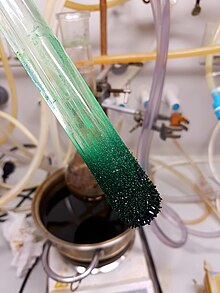Nickelocene
| |||
 | |||
| Names | |||
|---|---|---|---|
| Preferred IUPAC name Nickelocene[1] | |||
| Other names Bis(cyclopentadienyl) nickel(II) | |||
| Identifiers | |||
CAS Number |
| ||
3D model (JSmol) |
| ||
| ChEBI |
| ||
| ChemSpider |
| ||
| ECHA InfoCard | 100.013.672 | ||
| EC Number |
| ||
Gmelin Reference | 3412 | ||
PubChem CID |
| ||
| RTECS number |
| ||
| UNII |
| ||
| UN number | 1325 3082 | ||
CompTox Dashboard (EPA) |
| ||
InChI
| |||
| |||
| Properties | |||
Chemical formula | C10H10Ni | ||
| Molar mass | 188.88 g/mol | ||
| Appearance | Green crystals | ||
| Density | 1.47 g/cm3 | ||
| Melting point | 171 to 173 °C (340 to 343 °F; 444 to 446 K) | ||
Solubility in water | insoluble | ||
| Structure | |||
Coordination geometry | D5h, D5d | ||
Dipole moment | 0 D | ||
| Hazards | |||
| GHS labelling: | |||
   | |||
| Danger | |||
| H228, H302, H317, H350 | |||
| P201, P202, P210, P240, P241, P261, P264, P270, P272, P280, P281, P301+P312, P302+P352, P308+P313, P321, P330, P333+P313, P363, P370+P378, P405, P501 | |||
| NFPA 704 (fire diamond) |  2 4 2 | ||
| Lethal dose or concentration (LD, LC): | |||
LD50 (median dose) | 490 mg kg−1 (oral, rat) 600 mg kg−1 (oral, mouse) | ||
| Related compounds | |||
Related compounds | CoCp2, FeCp2 | ||
Except where otherwise noted, data are given for materials in their standard state (at 25 °C [77 °F], 100 kPa).  N verify (what is N verify (what is  Y Y N ?) N ?) Infobox references | |||
Nickelocene is the organonickel compound with the formula Ni(η5-C5H5)2. Also known as bis(cyclopentadienyl)nickel or NiCp2, this bright green paramagnetic solid is of enduring academic interest,[2] although it does not yet have any known practical applications.
Structure
Ni(C5H5)2 belongs to a group of organometallic compounds called metallocenes. Metallocenes usually adopt structures in which a metal ion is sandwiched between two parallel cyclopentadienyl (Cp) rings. In the solid-state, the molecule has D5d symmetry, wherein the two rings are staggered.[3]
The Ni center has a formal +2 charge, and the Cp rings are usually assigned as cyclopentadienyl anions (Cp−), related to cyclopentadiene by deprotonation. The structure is similar to ferrocene. In terms of its electronic structure, three pairs of d electrons on nickel are allocated to the three d orbitals involved in Ni–Cp bonding: dxy, dx2–y2, dz2. The two remaining d-electrons each reside in the dyz and dxz orbitals, giving rise to the molecule's paramagnetism, as manifested in the unusually high field chemical shift observed in its 1H NMR spectrum. With 20 valence electrons, nickelocene has the highest electron count of the transition metal metallocenes. Cobaltocene, Co(C5H5)2, with only 19 valence electrons is, however, a stronger reducing agent, illustrating the fact that electron energy, not electron count determines redox potential.
Preparation
Nickelocene was first prepared by E. O. Fischer in 1953, shortly after the discovery of ferrocene, the first metallocene compound to be discovered.[4] It has been prepared in a one-pot reaction, by deprotonating cyclopentadiene with ethylmagnesium bromide, and adding anhydrous nickel(II) acetylacetonate.[5] A modern synthesis entails treatment of anhydrous sources of NiCl2 (such as hexaamminenickel chloride) with sodium cyclopentadienyl:[6]
- [Ni(NH3)6]Cl2 + 2 NaC5H5 → Ni(C5H5)2 + 2 NaCl + 6 NH3
Properties
Like many organometallic compounds, Ni(C5H5)2 does not tolerate extended exposure to air before noticeable decomposition.[7] Samples are typically handled with air-free techniques.
Most chemical reactions of nickelocene are characterized by its tendency to yield 18-electron products with loss or modification of one Cp ring.
- Ni(C5H5)2 + 4 PF3 → Ni(PF3)4 + organic products
The reaction with secondary phosphines follows a similar pattern:
- 2 Ni(C5H5)2 + 2 PPh2H → [Ni2(PPh2)2(C5H5)2] + 2 C5H6
Nickelocene can be oxidized to the corresponding cation, which contains Ni(III).
Gaseous Ni(C5H5)2 decomposes to a nickel mirror upon contact with a hot surface, releasing the hydrocarbon ligands as gaseous coproducts. This process has been considered as a means of preparing nickel films.
Nickelocene reacts with nitric acid to produce cyclopentadienyl nickel nitrosyl, a highly toxic organonickel compound.
References
- ^ International Union of Pure and Applied Chemistry (2014). Nomenclature of Organic Chemistry: IUPAC Recommendations and Preferred Names 2013. The Royal Society of Chemistry. p. 1041. doi:10.1039/9781849733069. ISBN 978-0-85404-182-4.
- ^ Elschenbroich, C. (2006). Organometallics. Weinheim: Wiley-VCH. ISBN 978-3-527-29390-2.
- ^ P. Seiler; J. D. Dunitz (1980). "The structure of nickelocene at room temperature and at 101 K". Acta Crystallogr. B36 (10): 2255–2260. doi:10.1107/S0567740880008539. S2CID 93575701.
- ^ Fischer, E. O.; Pfab, W. (1952). "Zur Kristallstruktur der Di-Cyclopentadienyl-Verbindungen des zweiwertigen Eisens, Kobalts und Nickels" [On the crystal structure of biscyclopentadienyl compounds of divalent iron, cobalt and nickel]. Z. Naturforsch. B. 7: 377–379. doi:10.1515/znb-1952-0701. S2CID 93978102.
- ^ Wilkinson, G.; Pauson, P. L.; Cotton, F. A. (1954). "Bis-cyclopentadienyl Compounds of Nickel and Cobalt". J. Am. Chem. Soc. 76 (7): 1970–4. doi:10.1021/ja01636a080.
- ^ Girolami, G. S.; Rauchfuss, T. B.; Angelici, R. J. (1999). Synthesis and Technique in Inorganic Chemistry. Mill Valley, CA: University Science Books. ISBN 0935702482.
- ^ Jaworska-Augustyniak, Anna; Wojtczak, Jan (1979). "Charge-transfer complexes of cobaltocene and nickelocene with tetrachloromethane". Monatshefte für Chemie. 110 (5): 1113–1121. doi:10.1007/BF00910959. S2CID 91737661.
External links
- IARC Monograph "Nickel and Nickel compounds"
- National Pollutant Inventory – Nickel and compounds Fact Sheet













